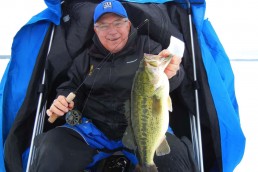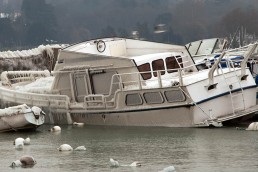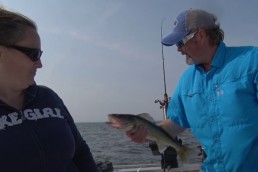Dave Genz and the Holey Boat
SHARE THIS POST
While El Niño keeps the MidWest climate warmer than it should be for December and many lakes stay unfrozen, you can bet the man who taught North America how to ice fish more effectively will still staring at his Vexilar flasher, watching his jig tempt fish to bite. In fact, Dave Genz has been jigging the short rods and hoisting panfish through a hole all summer and fall. The hole is in his appropriately named “Holey Boat.” It’s an aluminum 18-footer with two holes cut through the hull that are the same size as the holes that he fishes through on the ice.
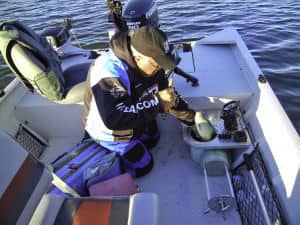
In September, I spent some time with Genz, a guy who most serious ice anglers have heard of and learned from. Although I didn’t get to fish out of the Hole-y Boat, he did give me a walk-through if this interesting craft, telling me that a lot of what he’s learned in decades of ice fishing helps catch panfish and more in the open water. And he actually does it on short ice-fishing rods, light line with ice jigs right through the hull of his aluminum G-3 brand boat.
Genz, yours truly and a bunch of other communicators were gathered for the annual conference of the Association of Great Lakes Outdoor Writers in Minneapolis Northwest.
A promoter for Clam Outdoor Products and captain of that company’s 36-member promotional Ice Team, Genz had a breakthrough idea that the same vertical presentations he used through the ice would work in open water. And they did, right over the side of the boat, but that wasn’t close enough to the actual ice-fishing experience. He wanted to replicate the ice-fishing set-up of a hole and a Vexilar sonar flasher unit, a common tool for today’s educated ice angler. So he bought the G3 boat and had 8-inch holes cut through the deck and hull. The holes have 8-inch pipe welded to the deck and hull to keep the boat watertight. When he starts the outboard and runs, he twists 8-inch plugs into the holes to keep water from gushing upward.
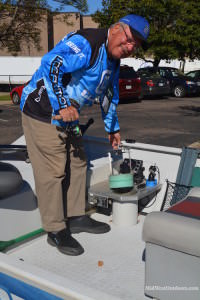
No one who knows Genz is surprised that this out-of-the-box idea effectively catches lots of fish. During the conference he took several writers fishing, and all caught nice-sized sunfish, crappies and even a walleye or two on short ice rods and ice jigs.
The whole set-up also relies on a couple of 30-pound anchors at the bow and stern to keep the boat stationary in the open water. Genz finds the spot he wants to fish and lowers the anchors with a push of a couple buttons that control the Minn Kota Deckhand anchor winches.
Are you enjoying this post?
You can be among the first to get the latest info on where to go, what to use and how to use it!
“It’s just like ice fishing, watching the lure and the fish on the Vexilar,” Genz said. “At one spot when the wind was blowing, the fish were packed tight to the bottom, but you could see them come up as much as five feet to look at the jig. When the wind quit, they would only come a foot or so off the bottom up to the jig.”
Watching the sonar to see how fish react to his jigging presentation—sometimes they come up aggress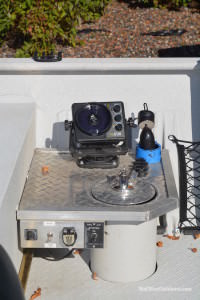 ively and sometimes they slowly ease into the sonar signal and look at the lure—helps him figure out how to work the jig to make the fish bite.
ively and sometimes they slowly ease into the sonar signal and look at the lure—helps him figure out how to work the jig to make the fish bite.
He said the same things that work through the ice get the fish to bite in open water, whether it’s jiggling the bait aggressively or subtly.
The boat also allows him to test the tackle that Clam Outdoors makes for use on the ice, even if there is no ice.
Genz told me about the Holey Boat at the 2014 conference and I was disappointed that our schedules didn’t work out to where I could have gone fishing with him that last week of September.
“You’ll just have to come to Minnesota so I can take you fishing next summer,” the affable fishing educator told me. I’m highly inclined to buzz over from Michigan and take him up on the offer.
MWO
SHARE THIS POST
Did you enjoy this post?
You can be among the first to get the latest info on where to go, what to use and how to use it!
MWO
We believe being outdoors is good. With more than 1,000 articles each year, MidWest Outdoors magazine is all about sharing outdoor experiences with you—where to go, what to use and how to use it… whether you’re close to home or on that trip of a lifetime.

